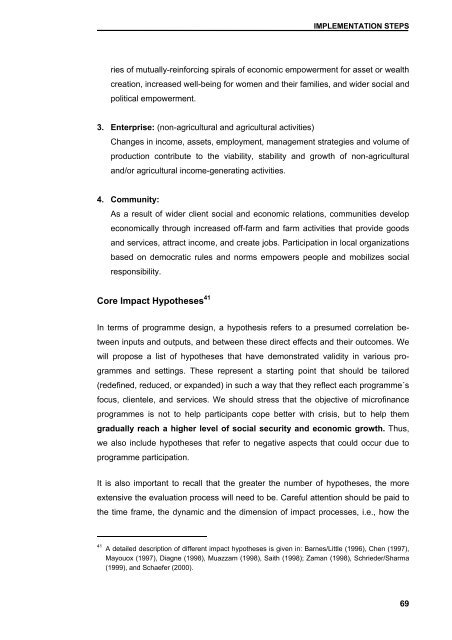Guidelines for Impact Monitoring & Assessment in Microfinance ...
Guidelines for Impact Monitoring & Assessment in Microfinance ...
Guidelines for Impact Monitoring & Assessment in Microfinance ...
You also want an ePaper? Increase the reach of your titles
YUMPU automatically turns print PDFs into web optimized ePapers that Google loves.
IMPLEMENTATION STEPS<br />
ries of mutually-re<strong>in</strong><strong>for</strong>c<strong>in</strong>g spirals of economic empowerment <strong>for</strong> asset or wealth<br />
creation, <strong>in</strong>creased well-be<strong>in</strong>g <strong>for</strong> women and their families, and wider social and<br />
political empowerment.<br />
3. Enterprise: (non-agricultural and agricultural activities)<br />
Changes <strong>in</strong> <strong>in</strong>come, assets, employment, management strategies and volume of<br />
production contribute to the viability, stability and growth of non-agricultural<br />
and/or agricultural <strong>in</strong>come-generat<strong>in</strong>g activities.<br />
4. Community:<br />
As a result of wider client social and economic relations, communities develop<br />
economically through <strong>in</strong>creased off-farm and farm activities that provide goods<br />
and services, attract <strong>in</strong>come, and create jobs. Participation <strong>in</strong> local organizations<br />
based on democratic rules and norms empowers people and mobilizes social<br />
responsibility.<br />
Core <strong>Impact</strong> Hypotheses 41<br />
In terms of programme design, a hypothesis refers to a presumed correlation between<br />
<strong>in</strong>puts and outputs, and between these direct effects and their outcomes. We<br />
will propose a list of hypotheses that have demonstrated validity <strong>in</strong> various programmes<br />
and sett<strong>in</strong>gs. These represent a start<strong>in</strong>g po<strong>in</strong>t that should be tailored<br />
(redef<strong>in</strong>ed, reduced, or expanded) <strong>in</strong> such a way that they reflect each programme´s<br />
focus, clientele, and services. We should stress that the objective of microf<strong>in</strong>ance<br />
programmes is not to help participants cope better with crisis, but to help them<br />
gradually reach a higher level of social security and economic growth. Thus,<br />
we also <strong>in</strong>clude hypotheses that refer to negative aspects that could occur due to<br />
programme participation.<br />
It is also important to recall that the greater the number of hypotheses, the more<br />
extensive the evaluation process will need to be. Careful attention should be paid to<br />
the time frame, the dynamic and the dimension of impact processes, i.e., how the<br />
41 A detailed description of different impact hypotheses is given <strong>in</strong>: Barnes/Little (1996), Chen (1997),<br />
Mayouox (1997), Diagne (1998), Muazzam (1998), Saith (1998); Zaman (1998), Schrieder/Sharma<br />
(1999), and Schaefer (2000).<br />
69

















![CynefinFramework final [Read-Only]](https://img.yumpu.com/19017304/1/190x135/cynefinframework-final-read-only.jpg?quality=85)